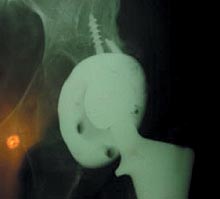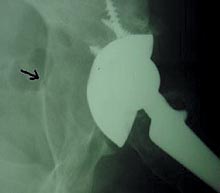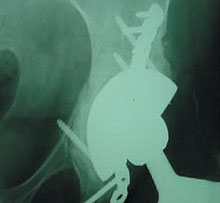Neglected osteolysis can lead to major reconstructive problems
The primary surgeon must routinely follow the patient to detect significant asymptomatic osteolysis.
![Thomas K. Fehring, MD [photo]](/~/media/images/news/print/orthopedics-today/2003/07_july/fehring_60_90_2092.jpg) ---Thomas Fehring is
co-director of the Charlotte Hip and Knee Center, a division of Charlotte
Orthopedic Specialists, in Charlotte, NC.
---Thomas Fehring is
co-director of the Charlotte Hip and Knee Center, a division of Charlotte
Orthopedic Specialists, in Charlotte, NC.
This month’s case is a 57-year-old, 180-lb patient who is 12 years status post primary total hip replacement with cementless components. At her three-month checkup, her treating surgeon told her to come back on an as-needed basis. She did reasonably well for 12 years but over the last six months she started to experience pain. A minor fall led to her presentation to her primary orthopedist. Following his evaluation, she was referred to our institution with a chief complaint of hip pain.
Physical examination: The patient walked with slight antalgia and had a positive Trendelenburg sign as well as a positive Trendelenburg lurch. She stated that her hip pain was much worse after her fall four weeks ago but now it was improving.
Radiographic evaluation: AP, lateral and oblique radiographs confirmed bony ingrowth of the femoral component and a laterally placed acetabular component. Significant periacetabular osteolysis was noted along with a fracture of the acetabulum.
Preoperative evaluation: Judet films confirmed the extensive osteolysis with the acetabular fracture at an early stage of healing. CRP and sed rate were performed, and they were normal.
Treatment options include:
- Conservative management: Continue to follow the patient clinically.
- Immediate revision with bone grafting of the defect and exchange of the polyethylene.
- Immediate revision with removal of the acetabular component, plating of the acetabular fracture and reconstruction based on the bony defect.
- Continued observation with protected weight-bearing for three months to try to allow the acetabular fracture to heal, then revision hip arthroplasty as above.
|
|
Surgical solution: Until this fall, this patient was relatively asymptomatic and therefore was not enthusiastic about pursuing a surgical solution to her problem. She was placed on a walker for approximately three months until we felt that she had reasonable healing of her acetabular fracture. Her pain diminished during this period. When she was painfree she was taken to the operating room where a revision total hip was performed. At the time of surgery, her femoral component was well ingrown but in approximately 50º to 60º of femoral anteversion. The cup was exposed in a 360º fashion and tested. It was not bone ingrown and was easily removed. A large medial cavitary defect was noted following cup extraction. There was reasonable superior bone stock. A transverse acetabular fracture was also noted that was slightly mobile.
Limited options
The transverse acetabular fracture limited the surgical options in this case. A posterior plating was performed with good fixation proximally and distally. The large cavitary defects were then bone grafted. The patient had a pillar of intact superior bone, and there was an intact rim. Given these parameters, we felt that a large porous cup had enough bone for ingrowth in this situation. Because the previous acetabular component was placed so far laterally, a lateralized acetabular component was chosen to maintain soft tissue tension. A Solution deep profile cup (DePuy/J&J) was used for reconstruction. Outstanding bites were achieved with the peripheral screws. Because of the significant over-anteversion on the femoral side, the acetabular component was placed in a less than normal anteverted position to avoid posterior impingement in external rotation and anterior instability.
Postoperatively, we plan an extensive period of touchdown weight-bearing in order for the bone ingrowth to occur in the limited areas available as well as to allow healing of the transverse acetabular fracture.
The importance of routine follow-up is highlighted by this case of neglected osteolysis. While the timing of intervention for periacetabular osteolysis is controversial, the importance of routine follow-up radiographs is not controversial. Proponents of either early or late intervention for osteolysis would agree that it is the responsibility of the primary surgeon to follow his or her patients on a routine basis to detect significant asymptomatic osteolysis.
Once periacetabular osteolysis is recognized, strategies to limit its extension must be formulated. Fortunately catastrophic failure secondary to acetabular osteolysis is relatively uncommon.
Large lesions seen radiographically are frequently noted in soft cancellous bone while the cup is supported by cortical struts and ingrowth at the rim. However, acetabular fractures associated with retroacetabular osteolysis have been reported.
Shorten follow-up intervals
It is difficult to discuss with the asymptomatic patient when to intervene when significant pelvic osteolysis is noted on routine follow-up radiographs. When significant osteolysis is noted, follow-up intervals should be shortened so that asymptomatic osteolysis can be followed carefully. If a very large lesion is encountered or a smaller lesion increases rapidly, prompt surgical intervention may be indicated. Also, if there is an acetabular component with a poor track record or an inadequate locking mechanism, surgery may also be recommended.
Because there is a paucity of literature concerning the natural history of these lesions, it is difficult to counsel our patients with asymptomatic osteolysis appropriately. While some authors are doing CT scans to document the amount of osteolysis in the hopes of predicting which patients need surgical intervention, we still take the approach that large lesions should be prophylactically treated even if they are asymptomatic. Until data are available to the contrary, polyethylene exchange and bone grafting of large lesions may be indicated before a catastrophic case such as this occurs.
For more information:
- Zimlich R, Fehring TK. Underestimation of pelvic osteolysis: The value of the iliac oblique radiograph. J Arthroplasty. 2000;15:796.
- Sanchez Sotelo J, McGrory BJ, Berry DJ. Acute periprosthetic fracture of the acetabulum associated with osteolytic pelvic lesions: A report of 3 cases. J Arthroplasty. 2000;15:544.
- Maloney WJ, Herzwurm P, Paprosky W, Rubash HE, Engh CA. Treatment of pelvic osteolysis associated with a stable acetabular component inserted without cement as part of a total hip replacement. J Bone Joint Surg. 1997;79A:1628.



